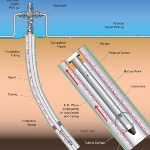Wireless Monitoring Success

Leading international oilfield service company Expro is pleased to announce the successful first installation of its new large-bore CaTS mandrel system in phase two wells of the Ormen Lange Field development in Norway. This success marks the first introduction of duplex (or two-way) communications functionality into Expro’s portfolio of wireless pressure/temperature monitoring and control products.With a growing track record in wireless data transmission from reservoir to surface, the introduction of duplex communications functionality in CaTS now enables commands to be transmitted from surface to downhole for the purpose of reconfiguring, or controlling downhole devices. Expro’s CaTS (Cableless Telemetry System) is a revolutionary development in the field of reservoir monitoring and control, allowing information to be transmitted in real time to and from downhole instruments without the use of cables. Its two-way transmission capability enables the remote control of downhole instrumentation, opening the path to the radical redesign of downhole completions.
CaTS mandrel systems were installed in Ormen Lange wells A5 and B7 early in 2009 and were commissioned successfully in October 2009. A further four systems are planned for installation during 2010/11.
Steve Hudson, Expro’s wireless well solutions’ technology manager, said: “Delivering the duplex communications capability from ‘reservoir to beach’ has been the most challenging engineering project that we have performed to date and this latest success is testament to the tenacity and ingenuity of the talented individuals we have working in our team here.”
Brian Champion, general manager of Expro’s wireless business unit, said: “We are seeing mounting interest from our clients in wireless solutions that will deliver across-the-reservoir monitoring and control without the need for cables or packer penetrations. The successful implementation of duplex in-well wireless communications in this deepwater, subsea, high rate gas well environment, together with the recent successful testing of our FlowCAT wireless flow control valve, marks a key achievement on the way to reaching our future goals in delivering production optimisation solutions.
“The logical next step is to apply the duplex wireless communications capability to selectively command inflow control devices that are located remotely across the producing reservoir interval.”






